动画: 黑洞摧毁恒星
See Explanation. Clicking on the video will download the highest resolution version available.
请参阅说明。单击视频将下载可用的最高分辨率版本。

See Explanation. Clicking on the video will download the highest resolution version available.
请参阅说明。单击视频将下载可用的最高分辨率版本。
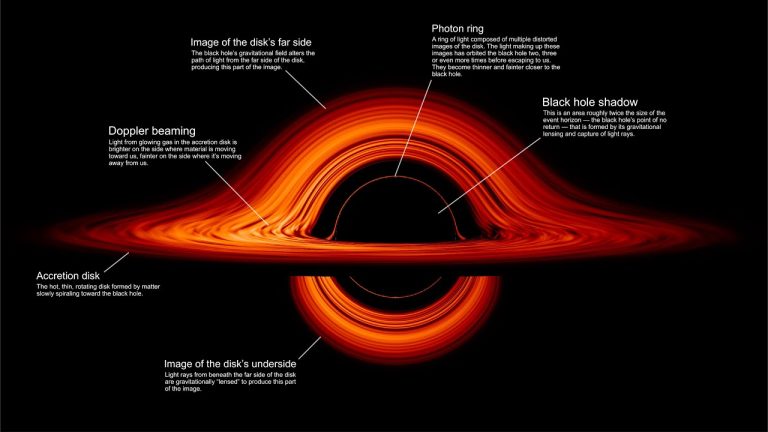
请参阅说明。单击视频将下载可用的最高分辨率版本。

一个旋转的蓝色吸积盘在中间有一个很深的彩色凹痕。一股浅色喷流从中间的一个小点(黑洞)射出。有关更多详细信息,请参阅说明。
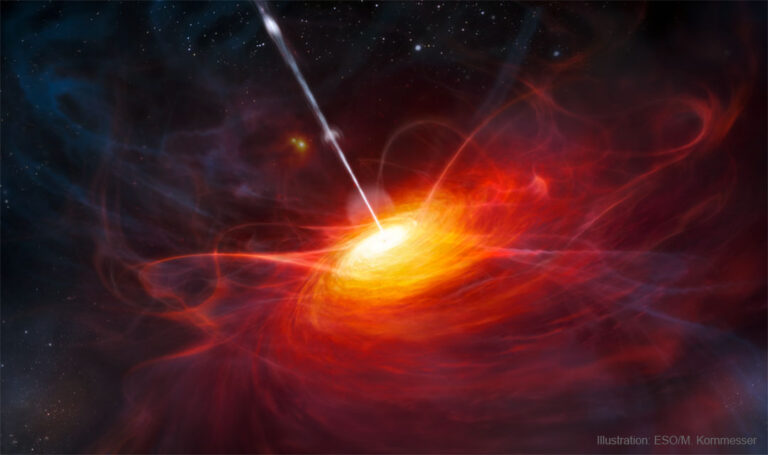
2022年2月22日 Illustration: An Early Quasar Illustration Credit & License: ESO, M. Kornmesser Explanation: What did the first quasars look like? The nearest quasars are now known to involve supermassive black holes in the centers of active galaxies. Gas and dust that falls toward a quasar glows brightly, sometimes outglowing the entire home galaxy. The quasars that formed in the first billion years of the universe are more mysterious, though. Featured, recent data has enabled an artist’s impression of an early-universe quasar as it might have been: centered on a massive black hole, surrounded by sheets of gas and an accretion disk, and expelling a powerful jet. Quasars are among the most distant objects we see and give humanity unique information about the early and intervening…
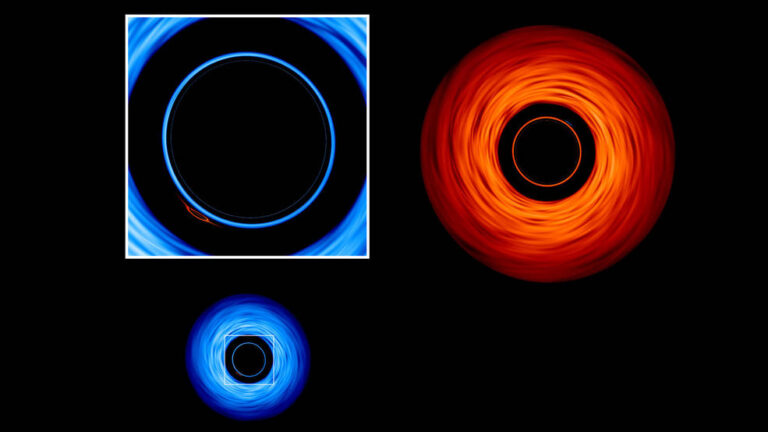
2021年04月16日 The Doubly Warped World of Binary Black Holes Scientific Visualization Credit: NASA, Goddard Space Flight Center, Jeremy Schnittman and Brian P. Powell – Text: Francis Reddy Explanation: Light rays from accretion disks around a pair of orbiting supermassive black holes make their way through the warped space-time produced by extreme gravity in this stunning computer visualization. The simulated accretion disks have been given different false color schemes, red for the disk surrounding a 200-million-solar-mass black hole, and blue for the disk surrounding a 100-million-solar-mass black hole. That makes it easier to track the light sources, but the choice also reflects reality. Hotter gas gives off light closer to the blue end of the spectrum and material orbiting smaller black holes experiences stronger gravitational effects…

2020年8月26日 Cygnus Skyscape Image Credit & Copyright: Alistair Symon Explanation: In brush strokes of interstellar dust and glowing hydrogen gas, this beautiful skyscape is painted across the plane of our Milky Way Galaxy near the northern end of the Great Rift and the constellation Cygnus the Swan. Composed using 22 different images and over 180 hours of image data, the widefield mosaic spans an impressive 24 degrees across the sky. Alpha star of Cygnus, bright, hot, supergiant Deneb lies near top center. Crowded with stars and luminous gas clouds Cygnus is also home to the dark, obscuring Northern Coal Sack Nebula, extending from Deneb toward the center of the view. The reddish glow of star forming regions NGC 7000 and IC 5070, the North America…
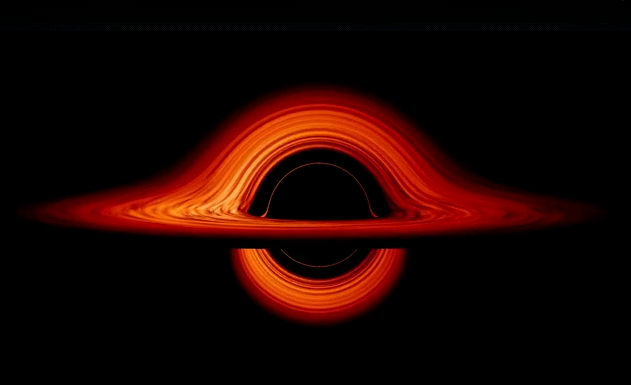
2020年8月25日 Visualization: A Black Hole Accretion Disk Visualization Credit: NASA’s Goddard Space Flight Center, Jeremy Schnittman Explanation: What would it look like to circle a black hole? If the black hole was surrounded by a swirling disk of glowing and accreting gas, then the great gravity of the black hole would deflect light emitted by the disk to make it look very unusual. The featured animated video gives a visualization. The video starts with you, the observer, looking toward the black hole from just above the plane of the accretion disk. Surrounding the central black hole is a thin circular image of the orbiting disk that marks the position of the photon sphere — inside of which lies the black hole’s event horizon. Toward the…
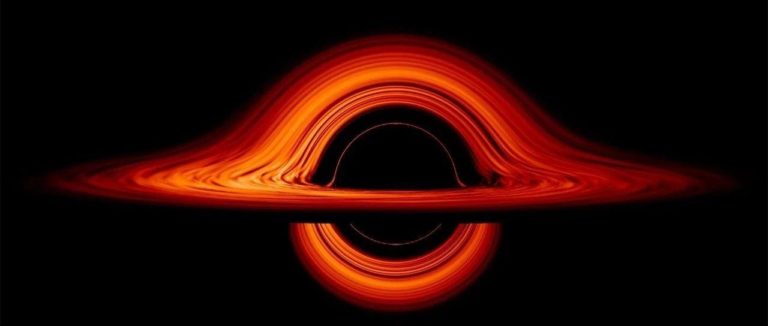
黑洞的最新可视化展示了黑洞的重力如何扭曲我们的视线及其周围的环境,就像在哈哈镜中看到的那样。可视化效果模拟了黑洞的外观:落入黑洞的物质积聚在一个又薄又热的结构中,称为吸积盘(accretion disk)。 随着磁场在气体的搅动中缠绕并扭曲,明亮的“结点”不断在吸积盘中形成并消散。最靠近黑洞的位置气体以接近光速运转,而外部速度更慢。这种速度差拉伸并剪切了这些明亮的“结点”,在吸积盘中产生了或明或暗的路线。 从侧面看,在黑洞周围的气体湍流呈现出神奇的双峰状外观。黑洞的极端重力会改变来自吸积盘不同部分的光的路径,从而产生这般扭曲的图像。侧视时扭曲的程度最大。 Credits: NASA’s Goddard Space Flight Center/Jeremy Schnittman 这张图注释了黑洞可视化中的各个部分。 Credits: NASA’s Goddard Space Flight Center/Jeremy Schnittman 从侧面看,吸积盘的左边看起来比右边更亮。这是因为左侧的发光气体在快速向我们移动,所以相对论使其亮度提高;右侧则相反,因为这一侧的气体离我们越来越远,所以看起来略微变暗。如果我们从吸积盘正上方看,这种不对称性便会消失,因为从该角度,我们的视线上没有物质移动。 靠近黑洞的地方,引力的效应如此之强,以至于吸积盘底面的光被弯曲到上面,看起来像勾勒黑洞轮廓的光环。这个所谓的“光子环”(photon ring)实际上由多个环组成,这些环绕黑洞两次、三次、甚至更多次,光环逐渐变暗变细,到后来逃离我们的“眼睛”。因为在这个可视化中建模的黑洞是球形的,光子环从任何角度看起来几乎是相同的圆形。光子环内部是黑洞的阴影,面积大约是事件视界(event horizon,“有去无回”的边界,即使是光也逃不出来)的两倍大小。 “爱因斯坦说过‘重力扭曲时空结构’,这样的模拟确实帮助我们了解了其中表达的含义,”这些图像的作者Jeremy Schnittman解释道,“在此之前,黑洞的可视化还受我们的想象力和计算机程序限制。我从来没有想过有可能看到一个真正的黑洞。” 在4月10日,通过对M87星系中心的无线电观测,事件视界望远镜(Event Horizon Telescope)团队发布了黑洞阴影的第一张图像。 参考 [1]https://www.nasa.gov/feature/goddard/2019/nasa-visualization-shows-a-black-hole-s-warped-world/ [2]https://svs.gsfc.nasa.gov/13326